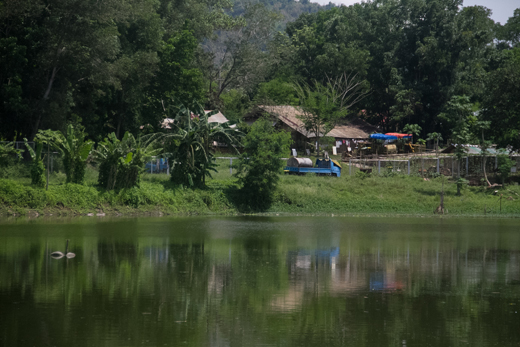
A lake in Barangay Sta. Lourdes, Puerto Princesa City which used to be the mine tailings pond of the defunct Palawan Quicksilver Mines, Inc. A number of residents here tested positive for mercury poisoning. (Photo by Celeste Anna R. Formoso)
PUERTO PRINCESA CITY, Palawan -- The Department of Health (DOH) is seeking the relocation of mercury-affected residents in a Puerto Princesa barangay who live near an abandoned mine site here before the start of their treatment for poisoning.
DOH-Mimaropa Environmental and Occupational Health Program Manager Dr. Rommel Lizan said Friday that mercury-affected residents of Barangay Sta. Lourdes in this city could already be treated through chelation therapy but need to be relocated first away from the contaminated area.
He said that the medicine for the therapy is already available, and is now stored in the toxicology department of the East Avenue Medical Center (EAMC) in Quezon City.
Severely affected patients could be treated in a local hospital in the province, and two doctors had already been trained on chelation therapy, Lizan said.
“We will not release [the medicines] unless the affected individuals for treatment have moved [out of the danger zone],” he said. He was unable to give details about what particular medicine they would use.
Lizan said those who need the chelation treatment should transfer away from the pit lake and the former mine site of the Palawan Quicksilver Mines, Inc. (PQMI) because the drugs it would use were powerful and like magnets that could even sop up mercury in their system.
“They will all the more absorb mercury in their system if they will continue living in that environment.
Also, chances are the mercury level in their body would go even higher,” the program manager said.
Chelation therapy is a procedure that employs the use of medicine to eliminate the build-up of metal poisons in the body, like arsenic, iron, lead, and mercury.
But Eduardo Driz, the housing chief of the city government of Puerto Princesa, said that as of the moment, only seven families had been relocated out of 30 from the seriously mercury-affected area in Sta. Lourdes.
“Maybe they are not interested in the relocation site or they don’t want to leave their houses in the site,” said Driz, adding that some families who do not want to leave apparently do not believe mercury is inside their bodies.
The cost of the therapy per person is PHP200,000 to PHP300,000 that will go from a minimum of three to six months, depending on the level of the poison and how the patient will react to the treatment.
The Philippine News Agency (PNA) first reported about the mercury poisoning in Sta. Lourdes in August 2017, when environment authorities raised the alarm that around 10,000 residents in the barangay are in danger of being gravely affected.
The said residents are found not only in Sta. Lourdes, but also in the neighboring barangay of Tagburos, which is also situated near the abandoned mercury mine site of the PQMI.
A summary report from the City Environment and Natural Resources Office (CENRO) claimed the residents are at risk of exposure to high levels of mercury as they are continuously exposed to mine tailings, and consume seafood caught from nearby Honda Bay.
The study noted that around 38 percent of Sta. Lourdes residents are suffering from lingering mercury poisoning. (With reports from Keith Anthony Fabro/PNA)
